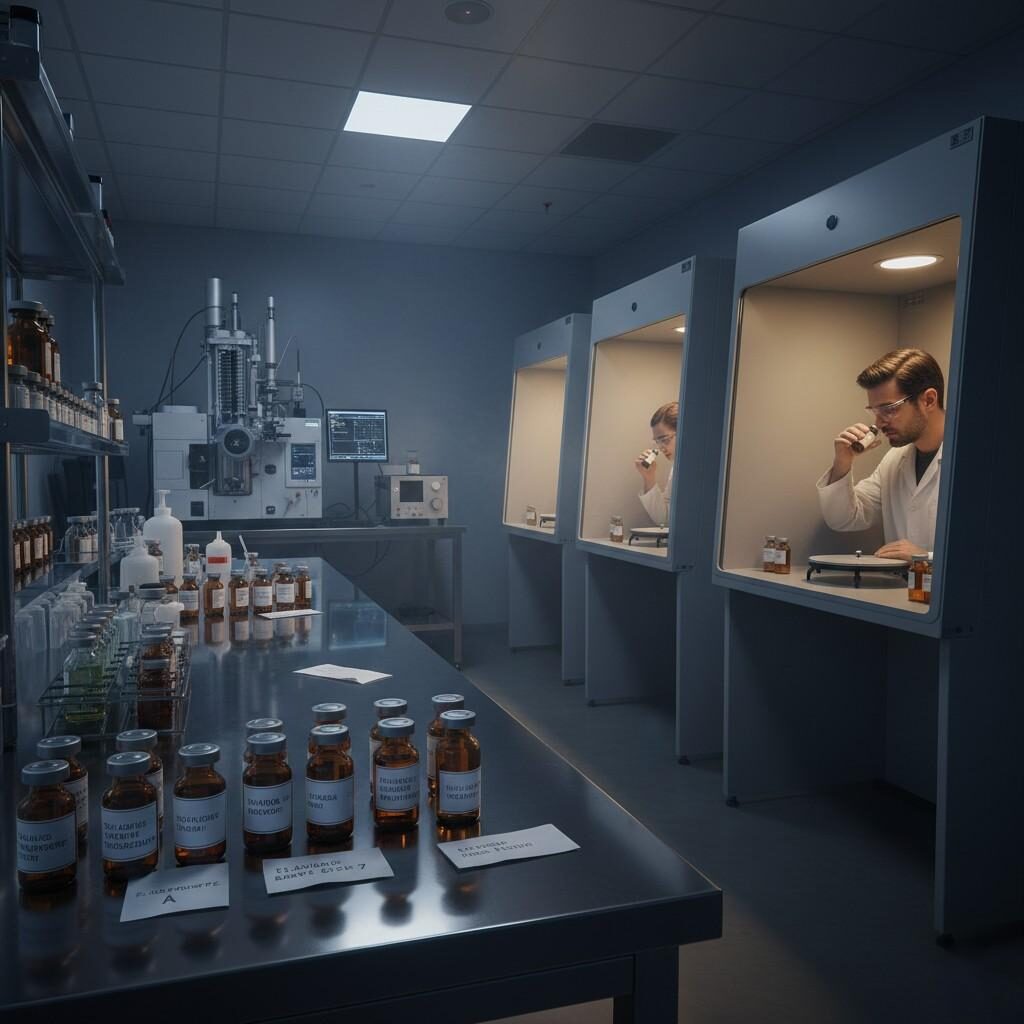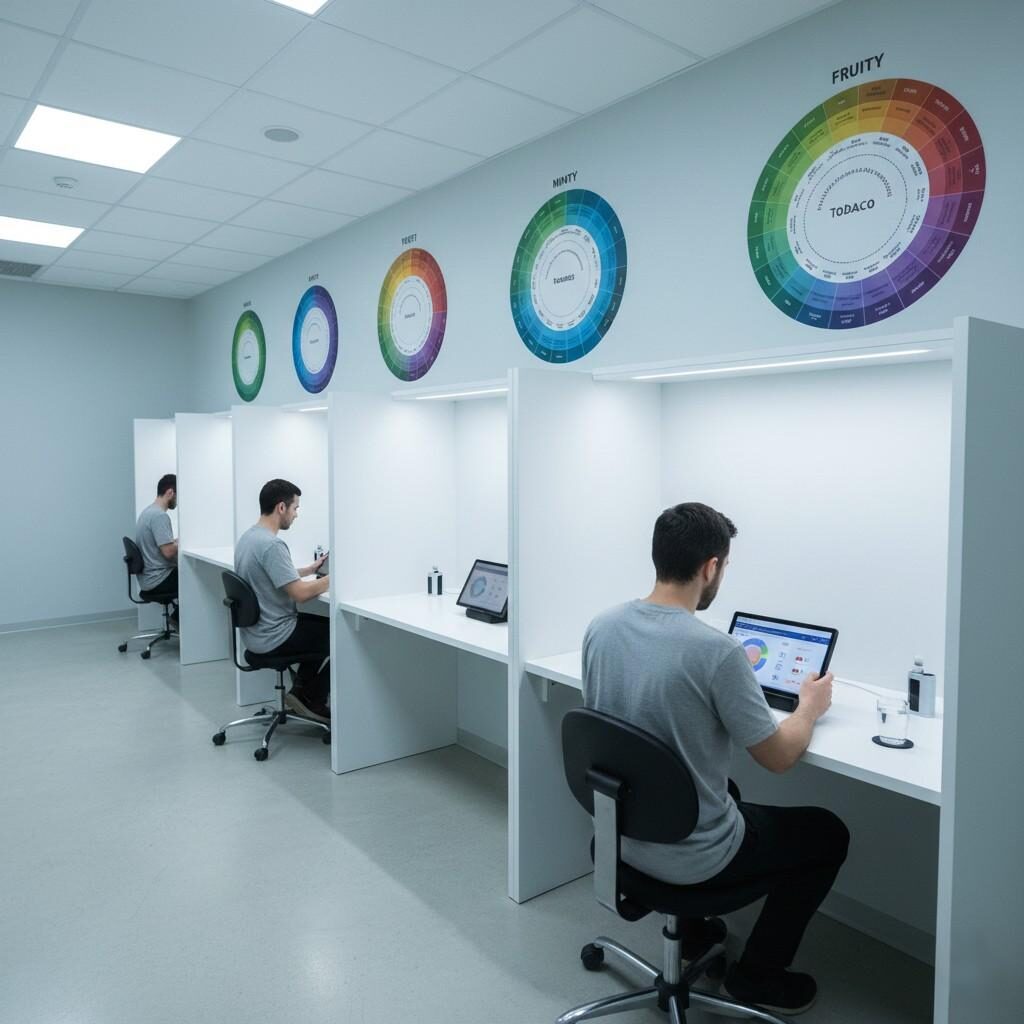Author: R&D Team, CUIGUAI Flavoring
Published by: Guangdong Unique Flavor Co., Ltd.
Last Updated: Nov 22, 2025

Vape Flavor R&D Lab
In the global e-liquid and vapor product industry, flavor has become the most decisive factor behind consumer retention, brand loyalty, and competitive differentiation. While hardware innovation has slowed, flavor innovation has accelerated. The brands that consistently launch successful formulas share one trait: a structured, data-driven sample feedback management system.
Flavor feedback is not merely a formality—it is the bridge between creative formulation and commercial success. When managed well, feedback cuts development cycles by half, reduces R&D costs, and ensures alignment between sensory intention and real-world performance. When handled poorly—through casual comments, inconsistent testing, or miscommunication—flavor projects become unpredictable, expensive, and slow.
Many brands struggle not because their flavorist is incompetent, but because feedback is fragmented, subjective, or poorly organized, leading to:
The purpose of this article is to provide e-liquid manufacturers, brands, and distributors with a complete framework to systematically manage flavor sample feedback. Backed by sensory science, analytical chemistry, and industrial workflow practices, this guide delivers everything needed to transform flavor feedback into a predictable, structured, and scalable system.
The vape industry is highly sensory-driven. However, most sensory processes used by small-to-medium vape brands are improvised. These patterns create structural failures that prevent efficient product development.
Typical vague comments:
These descriptors are subjective and scientifically meaningless. Sensory science literature confirms that ambiguous lexical descriptors reduce reproducibility and increase sensory variance (UC Davis Sensory Science Program) .
Different testers using:
This creates inconsistent vaporization temperatures and chemistry. The American Chemical Society notes that vape coil temperature significantly changes emitted volatile compounds, altering flavor perception.
Lighting, temperature, humidity, airflow, distracting odors—these all influence sensory evaluation. ISO 8589 establishes the standard for controlled sensory rooms, specifically warning that uncontrolled environments distort results.
Feedback without context (device, PG/VG ratio, power level, nicotine type) cannot be analyzed.
Teams frequently misplace:
Without proper documentation, each iteration becomes guesswork.
Five people tasting the same sample may produce different interpretations. Without a structured consensus-building system, feedback becomes noisy rather than actionable.
Systematic feedback management refers to a structured, repeatable, data-driven framework for capturing, analyzing, and applying sensory and analytical information.
A proper system includes:
With such a system, flavor development moves from “artistic guesswork” to scientific product engineering.

Vape Sensory Evaluation
Follow ISO 8589 sensory laboratory standards:
Each flavor must be prepared consistently:
Johns Hopkins University research indicates that coil temperature conditions can significantly alter the emitted concentrations of aldehydes, esters, and ketones, which explains inconsistent feedback across devices.
Each sample should be evaluated using quantitative scales:
Quantitative scoring transforms subjective impressions into measurable data.
Use sensory science approved descriptors, not emotional adjectives.
Examples:
Good descriptors:
Bad descriptors:
ISO 13299 confirms that common sensory vocabulary frameworks improve consistency and reduce subjective variability.
Your flavor feedback form is the backbone of systematic evaluation. It should include:
Encourage brief, precise statements like:
The customer should specify:
A simple system:
This structure reduces ambiguity and eliminates unnecessary sample loops.
Professional flavor development requires digital tracking similar to LIMS (Laboratory Information Management Systems).
A robust sample database should log:
Many brands improve approval rates by 30–50% once shifting from spreadsheets to structured tracking software.

Flavor R&D Dashboard
GC–MS is essential for understanding flavor behavior, diagnosing failure, and validating feedback.
GC–MS provides quantitative chemical fingerprints to support sensory impressions.
Chemical data + sensory data = accurate flavor decisions.
Flavor stability directly affects sample evaluation quality. Proper stability testing includes:
Expose samples to:
Observe color, aroma, and compound changes.
Aldehydes, ketones, and fruity esters degrade in UV/blue light.
Certain acids/base compounds influence ester hydrolysis.
Some compounds react with metal coil surfaces.
Studies show that temperature and oxidation significantly accelerate chemical changes in vape liquids (industry analytical reports).
A 3-tier priority model prevents “everything is urgent” chaos.
Must be fixed immediately:
Moderate priority:
Low priority:
This system ensures efficient allocation of R&D effort.
Systems succeed only when communication is structured.
Manufacturer should send:
If multiple people are tasting:
| Stage | Timeline |
| Initial sample design | 2–4 days |
| Customer evaluation | 3–7 days |
| Revision cycle | 2–4 days |
| Final approval | 1–2 cycles |
Internal team misalignment is one of the top causes of delayed flavor approval.
Without a structured system, the flavorist receives contradictory instructions.
This prevents chaotic iteration cycles.
Version control prevents misalignment, lost progress, and accidental duplication.
Each version must include:
Store all versions for:
A flavor development project without strict version control will always be unpredictable.
When sensory data, chemical data, and structured feedback are combined:
Brands using systematic feedback typically reduce development time by 40–60%.
A mid-size international vape brand approached our flavor R&D team with:
Systematic feedback is not a luxury—it is a competitive advantage.

E-liquid Flavor Manufacturing
A professional flavor supplier must provide capabilities far beyond simple mixing.
When you work with a manufacturer that uses systematic feedback, your success rate improves dramatically.
A flavor’s commercial success depends not just on creativity, but on scientific, structured, and well-managed feedback loops. Brands that adopt systematic feedback protocols consistently outperform competitors in:
If your organization wants to accelerate flavor development, reduce sample loops, and build more successful SKUs, our R&D team can support you with:
We provide free sample development + full technical consultation.
📧 Email: [info@cuiguai.com]
🌐 Website: [www.cuiguai.com]
📱 WhatsApp: [+86 189 2926 7983]
☎ Phone: [+86 0769 8838 0789]
Let us help you build flavors that perform consistently, pass sensory testing, and win in the global market.
The business scope includes licensed projects: food additive production. General projects: sales of food additives; manufacturing of daily chemical products; sales of daily chemical products; technical services, technology development, technical consultation, technology exchange, technology transfer, and technology promotion; biological feed research and development; industrial enzyme preparation research and development; cosmetics wholesale; domestic trading agency; sales of sanitary products and disposable medical supplies; retail of kitchenware, sanitary ware and daily sundries; sales of daily necessities; food sales (only sales of pre-packaged food).
Copyright ©Guangdong Unique Flavor Co., Ltd.All Rights Reserved. Privacy Policy